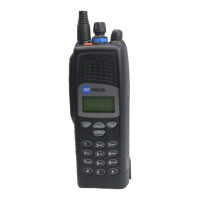TP9100 Service Manual Transmitter Fault Finding 245
© Tait Electronics Limited May 2005
Task 21 —
Check PIN Switch
In checking the final RF signal path, if no fault is found in the PA and driver,
then check the PIN switch next. The PIN switch may also require
investigation following certain checks in “Transmitter RF Power”.
1. Remove the
PA LPF BOT can.
2. Remove the blocking capacitor C160 (see Figure 10.11).
3. Solder one terminal of a 22pF (B1, H5, H6) test capacitor to the PCB
at the point shown in Figure 10.11. Mount the capacitor vertically.
Use a test capacitor of the type 0805 or the equivalent.
4. Solder a 50Ω test lead to the PCB. Solder the outer sheath to ground
and solder the central wire to the other terminal of the test capacitor.
5. Connect the test lead to the test set.
6. Enter the CCTM command 326 5 to set the transmitter power level
to the maximum.
7. Enter the CCTM command 101 x x 0, where x is the lowest
frequency (in hertz) for maximum power, as given in Table 10.6
(B1), Table 10.7 (H5), or Table 10.8 (H6).
8. Enter the CCTM command 33 to place the radio in transmit mode.
9. Measure the RF output power. This should exceed 6W (B1 band) or
5W (H5, H6).
10. Enter the CCTM command 32 to place the radio in receive mode.
11. Enter the CCTM command 101 x x 0, where x is the highest
frequency (in hertz) for maximum power, as given in Table 10.6
(B1), Table 10.7 (H5), or Table 10.8 (H6).
12. Repeat Step 8 to Step 10.
13. If the power in both the above cases exceeds 6W (B1) or 5W
(H5, H6), go to Step 14. If it does not, the circuitry of the PIN
switch is suspect; go to Tas k 2 2
.
14. Remove the test lead and test capacitor, resolder the blocking
capacitors in position, and go to Tas k 23
.
RF output power: more than 6W (B1), more than 5W (H5, H6)

